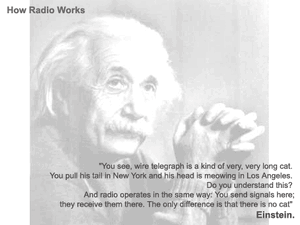Operations
The Amateur Code
The Radio Amateur is:
CONSIDERATE....
Never knowingly operates in such a way as to lessen the pleasure of others.
LOYAL....
Offers loyalty, encouragement, and support to other amateurs, local clubs, and the American Radio Relay League, through which Amateur Radio in the United States is represented nationally and internationally.
PROGRESSIVE...
With knowledge abreast of science, a well-built and efficient station and operation above reproach.
FRIENDLY...
Slow and patient operating when requested; friendly advice and counsel to the beginner; kindly assistance, cooperation and consideration for the interest of others. These are the hallmarks of the amateur service.
BALANCED...
Radio is an avocation, never interfering with duties owed to family, job, school or community.
PATRIOTIC...
Station and skill always ready for service to country and community.
The original Amateur's Code was written by Paul M. Segal, W9EEA, in 1928
Station Setup
Antenna
No matter what your license class, band of operation or mode of choice - likely the single biggest contributor to success or marginal operation is your antenna. A great radio, conected to a marginal antenna will give you marginal results. Likewise, using an excellent antenna on a marginal radio will give you near excellent results. In the audio world, they say 'speakers are everything'. In the RF world, antennas rule.
Many hams first radios are hand helds (HTs). The 'rubber duck' that comes with most HTs is really not too much more than a 'dummy load'. It provides matched load for the radio, but as a radiator, they leave a lot to be desired. One of the more common and popular methods of improving an HTs VHF/UHF performance is to 'home brew' an antenna. We did just that not too long ago using plans on the ARRL website to build DBJ-1 antennas. There's a newer, updated set of plans for the DBJ-2 also now available. As well as This article, which not only goes into more detail on the theory and design of the DBJ-2, but may well have been the basis for the QST article listed earlier.
This antenna may be a bit tricky for the first time builder, in that the RG-174 is very small and can be difficult to work with. If you built a 2m twin lead J-pole, it'll work for 70cm as well. But with less than optimal performance, as mentioned in the article.
Safety
Grounding
From Polyphaser, this article (pdf) is considered by many to be 'the' guide in setting up a station ground system.
This article (pdf) describes some of the considerations in designing a ground sysetm - namely, where does all that energy go?
More information, detail and background can be found at the Polyphaser site.
Informational
Band Plans
See the Band Plan page for lots of info on what and who goes where.
Modes
Some information on "modes" (including sound card digital) and "modulation" can be found on the digital page.
Modeling
Software
Using software, it's often advantageous and almost always informative to model a proposed installation before building it. This will allow you to see many of the unexpected problems.
nec2, miniNEC, EasyNEC
Smith Chart
Another analytical tool for antennas and feed lines is the Smith Chart. This daunting appearing tool can provide insights to design, performance and optimization without a computer. An engineer at TRW has made several presentations on the Smith Chart for ARRL gatherings. You can find the slides he uses for that presentation here.
HAAT
There's an article on the discussion board that talks about HAAT calculations and one way to do them.
Lightning
This PDF file, Elegant Connections will help in understanding just what, exactly, lightning is and why some of the commonly held 'wives tales' have some truth to them. As well as dispelling some of the myths - such as Benjamin Franklin's 'Discovery of Electricity'.
For many of these articles, you'll need Adobe's Acrobat Reader or another PDF file viewer.
Get Adobe Reader
Activities
For the VHF enthusiasts - there's a LOT out there to do! Take a look at Rocky Mountain VHF+.
The Rocky Mountain VHF+ is dedicated to promoting weak signal VHF/UHF/Microwave activities,
for both novices and veterans alike.Be sure to check in to our weekly net on
144.220 at 2000 local time each Monday night.
Rules & Regulations
See the band plans page for information on what modes to use where.
And here's a link to the ARRL copy of FCC Rules: Part 97 and other Rule Parts.
This link will take you to the US Government Printing Office's, 2007 online version of Title 47, part 97.
Casper APRS
Visit the APRS page for local APRS info, a live feed of the area's APRS activity and more.
